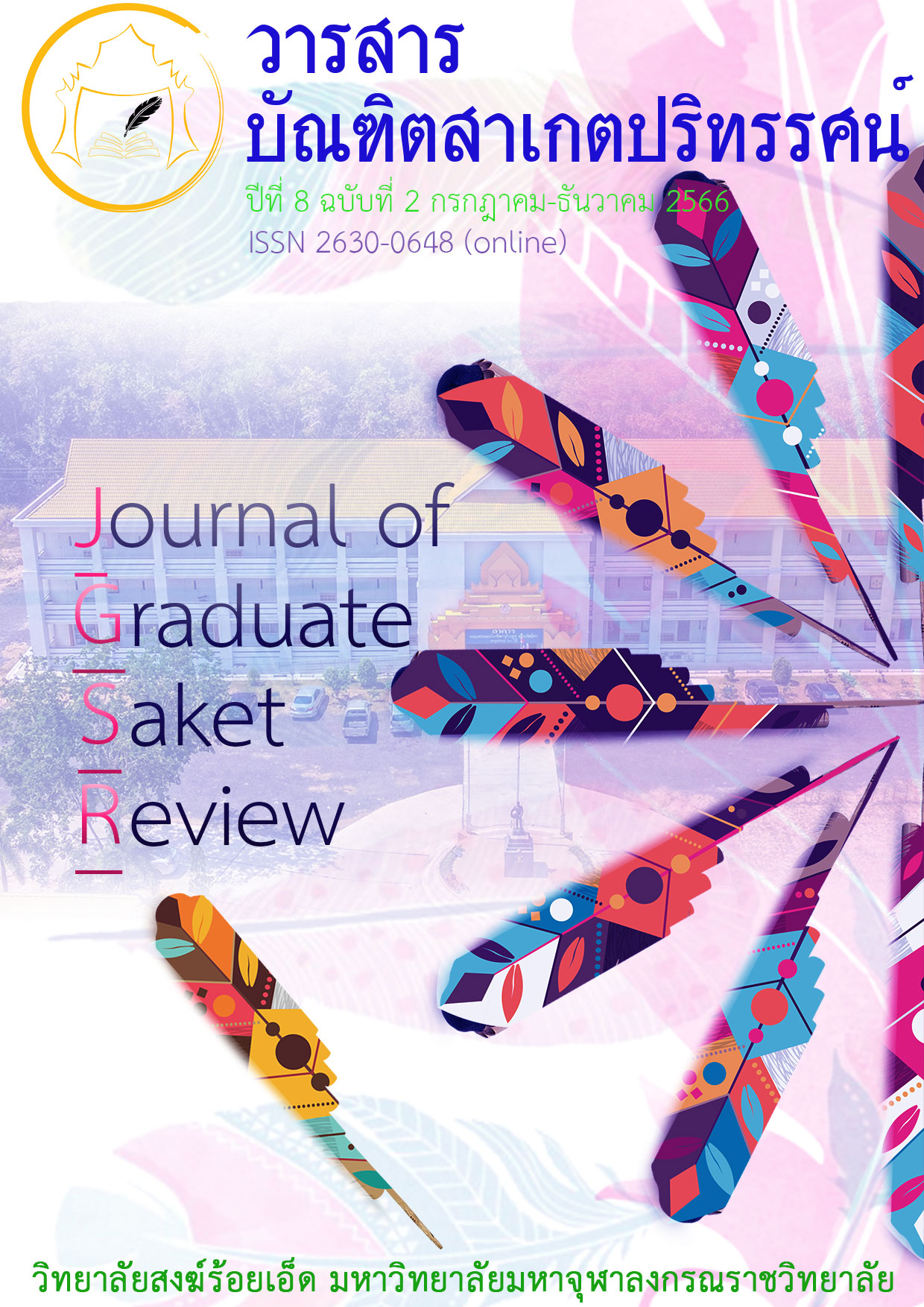An analytical study of Boon khoa Sak according to virtue principles in Buddhist ethics of the people of Nong Yai Sub-district, Si Somdet District, Roi Et Province
Main Article Content
Abstract
The objectives of this research paper were : 1) to study making merit method in Buddhism and Buddhist ethics , 2) to study making Boon Khoa Sak for the people of Nong Yai Sub-district, Sri Somdet District, Roi Et Province and 3) to analyze making Boon Khoa Sak according to the moral principles in Buddhist ethics of the people of Nong Yai Sub-district, Sri Somdet District, Roi Et Province. It is qualitative field research. Data were collected from a target group of 40 people using tools such as interviews and observation. The research results were presented using descriptive analysis.
The results of research found that :
Making merit in Buddhism is doing good deeds with an objective to increase good or good deeds for the person who makes merit and to get rid of selfishness out of the mind. Making merit is the cause of happiness, makes the mind blossom with merit, makes the mind as a pure, life is peaceful, meets only good things. There are many ways to make merit in Buddhism, such as giving , observing the precepts, mental developing, etc.
The people of Nong Yai Sub-district have made merit called Boon Khao Sak, a tradition of making merit that is dedicated or specific to the deceased ancestors and dedicate the merit to the beasts of the hell being or the departed being (Peta), popularly performed on the 15th full moon day of the 10th lunar month as an annual. Making merit according to such traditions will be consistent with the principle of making merit in Buddhism on giving, but the giving here is giving to the deceased ancestors.
According to the Buddhist ethics, it can be seen that the merit making is related to the moral principle of Katannukatavedi (one who is thankful for benefits received reciprocates them). It is to know the patronage that a person has already done and to repay or satisfy them. It can be divided into two levels: 1) those who have personal merit or support and 2) those who have served or have virtues that are beneficial to the public.
Article Details

This work is licensed under a Creative Commons Attribution-NonCommercial-NoDerivatives 4.0 International License.
เนื้อหาและข้อมูลในบทความที่ลงตีพิมพ์ในวารสารบัณฑิตสาเกตปริทรรศน์ ถือเป็นข้อคิดเห็นและความรับผิดชอบของผู้เขียนบทความโดยตรงซึ่งกองบรรณาธิการวารสาร ไม่จำเป็นต้องเห็นด้วย หรือร่วมรับผิดชอบใด ๆบทความ ข้อมูล เนื้อหา รูปภาพ ฯลฯ ที่ได้รับการตีพิมพ์ในวารสารบัณฑิตสาเกตปริทรรศน์ ถือเป็นลิขสิทธิ์ของวารสารบัณฑิตสาเกตปริทรรศน์ หากบุคคลหรือหน่วยงานใดต้องการนำทั้งหมดหรือส่วนหนึ่งส่วนใดไปเผยแพร่ต่อหรือเพื่อกระทำการใด ๆ จะต้องได้รับอนุญาตเป็นลายลักอักษรจากวารสารบัณฑิตสาเกตปริทรรศน์ ก่อนเท่านั้น
References
กรมศิลปากร. (2559). ฮีตที่ 10 บุญข้าวสากหรือบุญข้าวสาก. สืบค้นเมื่อ, 7 กรกฎาคม 2565, จาก www.nectec.or.th/schoolnetibrary/webcontestwoom/cooteam/dnesobo/heeto/heet@o.hm.
ขนิษฐา จิตชินะกุล. (2545). คติชนวิทยา. กรุงเทพมหานคร: โอเดียนสโตร์.
ขันเตียน นามเกตุ. (2556). การศึกษาคติความเชื่อประเพณีบุญเดือนเก้า (ข้าวประดับดิน). วิทยานิพนธ์พุทธศาสตรมหาบัณฑิต. บัณฑิตวิทยาลัย: มหาวิทยาลัยมหาจุฬาลงกรณราชวิทยาลัย.
พระครูใบฎีกาเฉลิมพล อริยวํโส (คำเชื้อ). (2554). การศึกษาวิเคราะห์ปุพพเปตพลีที่ปรากฎในคัมภีร์ใบลานล้านนา กรณีศึกษาคัมภีร์เปตตพลีฉบับวัดหลวงราชสัณฐาน. วิทยานิพนธ์พุทธศาสตรมหาบัณฑิต. บัณฑิตวิทยาลัย: มหาวิทยาลัยมหาจุฬาลงกรณราชวิทยาลัย.
พระมหาสุพจน์ คำน้อย. (2553). ศึกษาเกี่ยวกับคำสอนเรื่องการอุทิศส่วนบุญในพระพุทธศาสนาเถรวาท. วิทยานิพนธ์พุทธศาสตรมหาบัณฑิต. บัณฑิตวิทยาลัย: มหาวิทยาลัยมหาจุฬาลงกรณราชวิทยาลัย.
พระพรหมคุณาภรณ์ (ป.อ. ปยุตฺโต). (2547). พจนานุกรมพุทธศาสน์ ฉบับประมวลศัพท์. กรุงเทพมหานคร: มูลนิธิการศึกษาเพื่อสันติภาพพระธรรมปิฎก.
มหาจุฬาลงกรณราชวิทยาลัย. (2539). พระไตรปิฎกภาษาไทย ฉบับมหาจุฬาลงกรณราชวิทยาลัย.กรุงเทพมหานคร: มหาจุฬาลงกรณราชวิทยาลัย.
แม่ชีดวงพร คําหอมกุล. (2554). การศึกษาเชิงวิเคราะห์พุทธจริยศาสตร์ในธัมมปทัฏฐกถา. วิทยานิพนธ์พุทธศาสตรมหาบัณฑิต. บัณฑิตวิทยาลัย: มหาวิทยาลัยมหาจุฬาลงกรณราชวิทยาลัย.
สมเด็จพระพุทธโฆษาจารย์ (ป.อ. ปยุตฺโต). (2562). พุทธธรรม ฉบับปรับขยาย เล่มที่ 2. (พิมพ์ครั้งที่ 52). กรุงเทพมหานคร: สำนักพิมพ์ผลิธัมม์.
Fine Arts Department. (2016). Heat number 10: Bun Khao Sak or Bun Khao Sak. Retrieved on, 7 July 2022, from www.nectec.or.th/ schoolnetibrary/ /cooteam/dnesobo/heeto/heet@o.hm.
Jitchinakul K.. (2002). Folklore. Bangkok: Odean Store.
Mahachulalongkornrajavidyalaya. (1996). Thai Tripitaka Mahachulalongkorn rajavidyalaya Edition. Bangkok: Mahachulalongkornrajavidyalaya.
Mae Chi Duangporn Khamhomkul. (2011). Analytical study of Buddhist ethics in Dhammapathathakatha. Master of Buddhist Studies Thesis. Graduate School: Mahachulalongkornrajavidyalaya University.
Namket K.. (2013). A study of the beliefs and traditions of the merit-making tradition of the ninth lunar month (Rice decorated with soil). Master of Buddhist Studies Thesis. Graduate School: Mahachulalongkornrajavidyalaya University.
Phrakru Baidika Chaloemphon Ariyawamso (Khamchuea). (2011). An analytical study of Puppet Phli appearing in the Lanna leaf scriptures. A case study of the Petta Phli scriptures, Wat Luang Ratchasanthan edition. Master of Buddhist Studies Thesis. Graduate School: Mahachulalongkornrajavidyalaya University.
Phra Maha Suphot Khamnoi. (2010). Study on the teachings on dedicating merit in Theravada Buddhism. Master of Buddhist Thesis. Graduate School: Mahachulalongkornrajavidyalaya University.
Phra Brahmakunaphon (P.A. Payutto). (2004). Dictionary of Buddhism Glossary edition. Bangkok: Dhamma Pitaka Education for Peace Foundation.
Somdet Phra Buddhakosajarn (P.A. Payutto). (2019). Buddhadhamma expanded edition volume 2. (52nd). Bangkok: Phlitham Publishing House.


